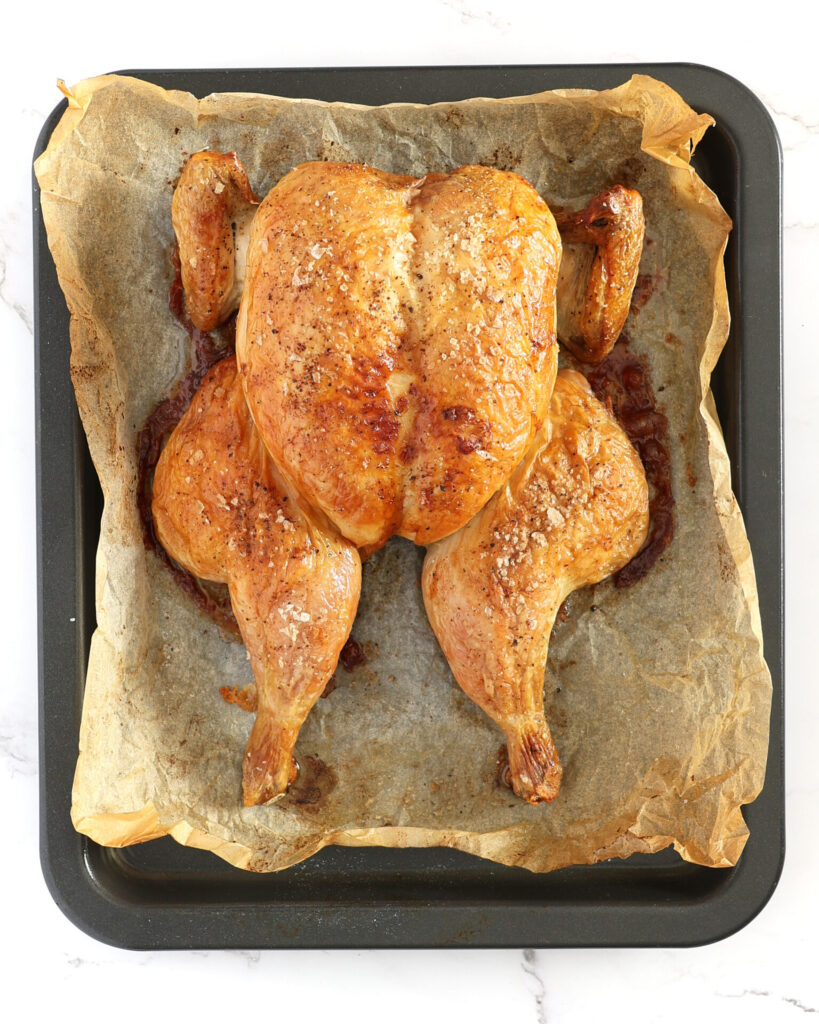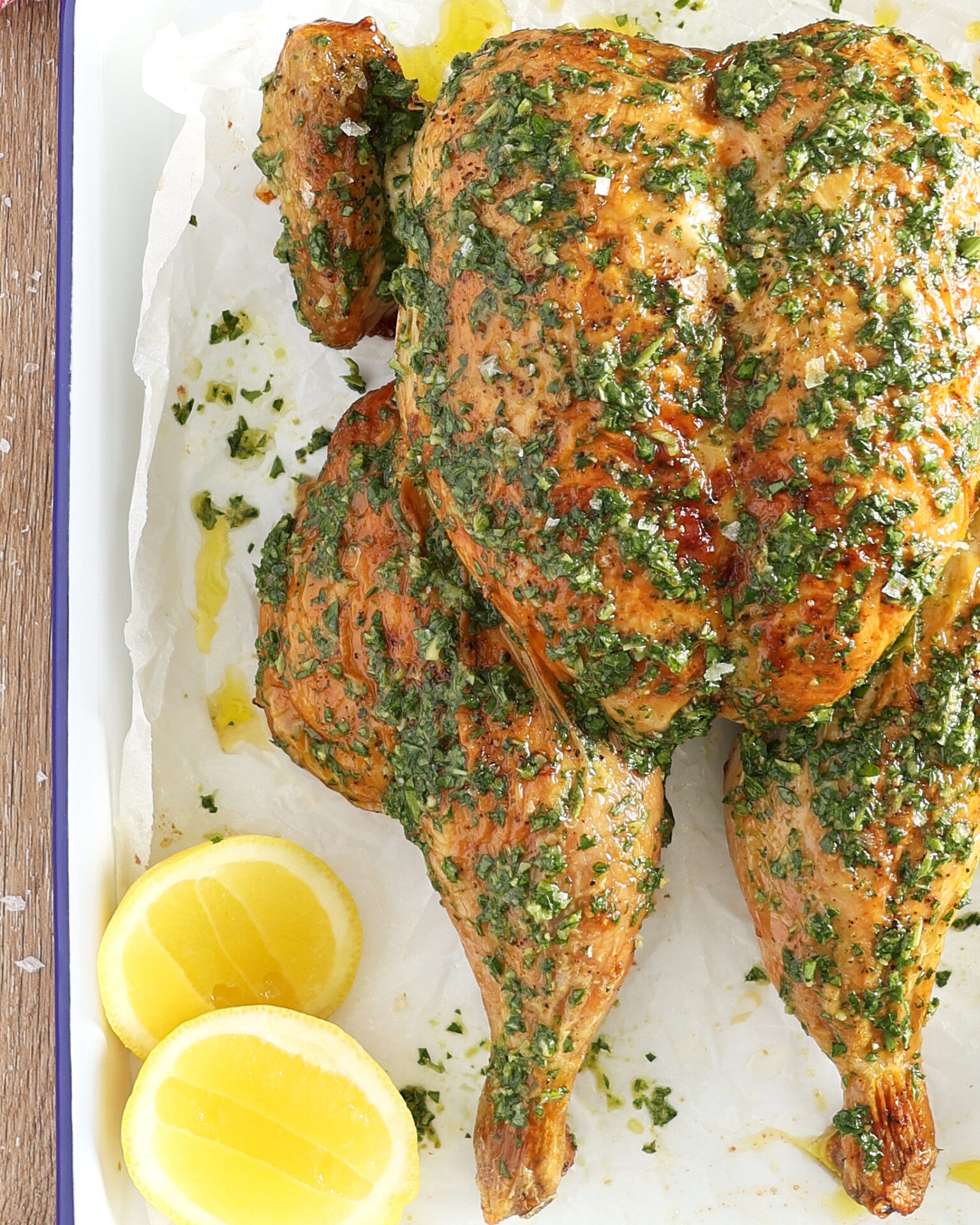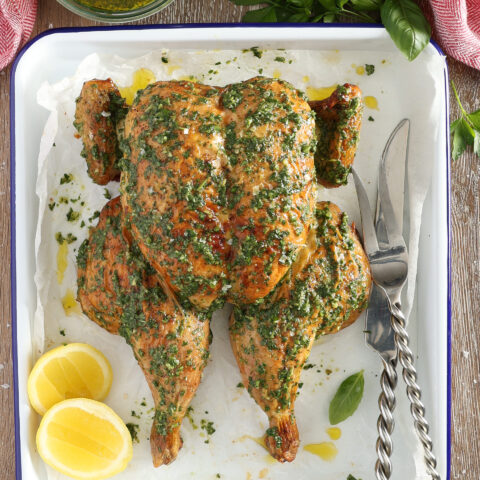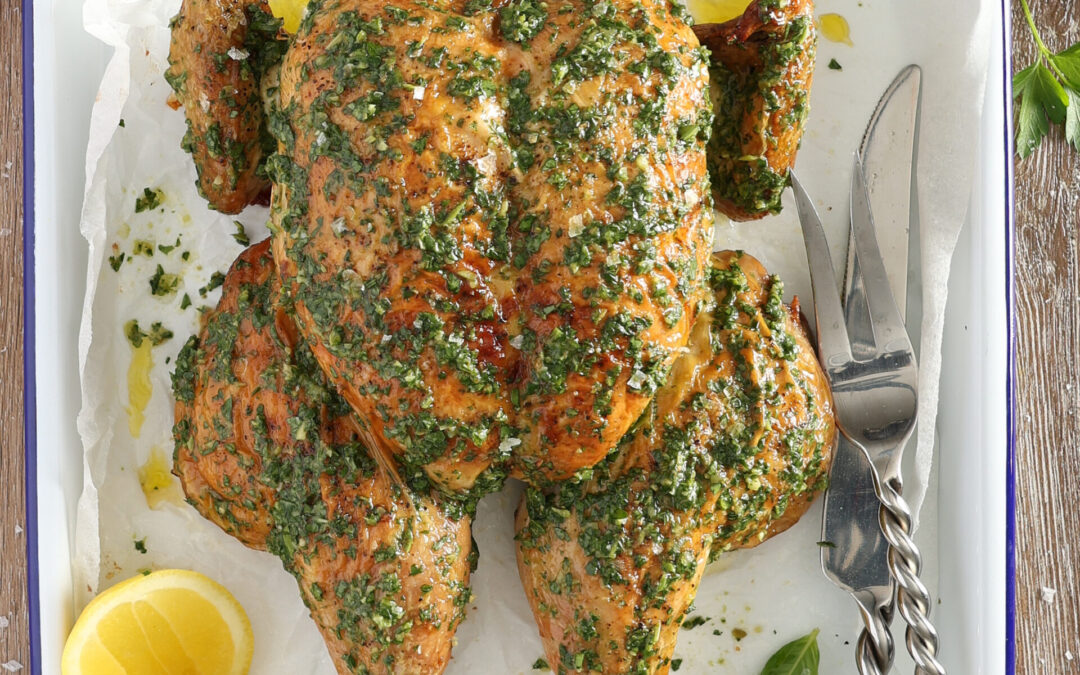What goes with salsa verde you ask? Let’s just say you asked. Of course, it’s my spatchcocked roast chicken recipe!
I promise my technique of combining a hot fan forced oven with a butterflied whole chicken will result in a perfect roast chicken every time. And covering it straight out of the oven with salsa verde will take your roast bird from delicious to brilliant!
Call it spatchcocking or butterflying, either way it is the only way to roast a whole chicken in my opinion. Flattening out the chicken allows even cooking and, as it’s thinner, it will cook faster. Using a hot oven gets you super crispy skin and much juicier meat. It’s even easier to portion. Honestly, I just chop it up after pulling off the Maryland joint (legs and thighs).
Make sure you scroll down to the short video where I demonstrate how to butterfly a whole chicken.
Adding salsa verde to the cook won’t blow out your dinner prep time as you can get it done while the chicken is in the oven. After basting the hot chicken with the sauce, the rest of the sauce goes to the table as a condiment. I guarantee there will be no sauce or chicken left at the end of the meal.
Make sure you get my salsa verde recipe into your repertoire. And have you already joined the ‘mayo rub’ party? I have and showcase the technique in my recipe for Salsa Verde Mayo Chicken Kebab.
How to butterfly a whole chicken
The key to successfully butterflying poultry is to own a pair of good quality poultry shears. Mine are spring loaded, which assist with getting through the bones.
Once you get the hang of spatchcocking you’ll never roast a whole chook any other way. I even use this method for turkey.
The hip joint can be pretty hard to get through unless you avoid the bones and cut through the cartilage. To assist in getting you in the right place, its best to dislocate the hips before starting. This enables you to feel your way past the large bones as you cut.
The whole spine comes out and can be used for broth if you’re planning on gravy rather than salsa verde as your sauce.
Make sure you crack the breastbone to ensure your bird is as flat as possible.
Ready for the oven

Preheat your oven to 230°C (fan forced).
As shown in the image you want to roast the chicken breast side up in a roasting pan lined with baking paper. Make sure the sides of the pan are no more than 5cm high as you want the hot air to circulate around the bird. You can place the chicken on a rack but it will make a lot of smoke at this temperature. And I have set off my smoke alarms when I’ve tried using a rack.
Tuck in the wing tips, as they tend to burn at this heat. And turn the thigh joints so the legs are meeting in the middle of the bird. This way the thighs will get even heat and help protect the breast meat as it cooks.
Simply season with salt and pepper, as the salsa verde will carry the flavour load!
When is my whole roast chicken done?

I generally roast chickens that weigh around 1.5kg. At 230°C (fan forced) they take 40-45 minutes on the middle oven rack to come out perfectly cooked and still moist.
You can monitor the temperature and I will use an instant read themometer or a meat thermometer that I can monitor on my mobile phone.
But chicken is one of the few meats that is happy to tell you when it is cooked. I suscribe to the ‘tug on the leg’ method of doneness. So, about 10 mins shy of the approximate cook time, I start tugging. If the leg pulls back and fights you, it needs more time. But if the leg and thigh pull away easily at the hip joint, your bird is done.
There is considerable variation in advice on what temperature your chicken needs to get to so it is safe to eat. Dark meat definitely needs to get 74°C but the breast meat will be safe at around 65°C. The spatchcocking aids in this differential cooking as the dark meat gets more direct heat than the breasts. I find if you take the breast meat to 74°C you risk them becoming dried out.
There are two things to remember here when trying for a perfectly moist chicken. First, you want to get your chicken out of the fridge and on the bench for at least an hour before roasting it. But do not leave it out for more than 2 hours before roasting. If you start with the chicken at room temperature, it will get to a safe temperature in the middle much quicker. Secondly, remember the internal temperature of the chicken will continue to rise for a short time after you take it out of the oven. To allow for this, I take it out when it is two degrees below my target temperature.


Salsa Verde Roast Chicken
Equipment
- Food processor
- Salad spinner
- 500ml plastic or glass jar with lid
- Poultry shears
- Roasting pan
- Instant thermometer (optional)
Ingredients
Roast Chicken:
- 1.5 kg whole chicken
- Salt and black pepper
Salsa Verde:
- 100 g fresh basil (6 cups loosely packed leaves)
- 100 g continental parsley (6 cups loosely packed leaves)
- 4 small garlic cloves
- 2 tablespoons capers (drained)
- 4 anchovies
- 1 tablespoon Dijon mustard
- 1 teaspoon white sugar
- 1 teaspoon sea salt
- 2 – 4 tablespoons red wine vinegar
- 200 – 300ml extra virgin olive oil
Instructions
Roast Chicken:
- Preheat oven 250°C fan forced (use middle rack).
- Remove chicken from the fridge 1-2 hours before cook time.
- Spatchcock/butterfly chicken (see video).
- Dry inside of chicken with paper towels.
- Line a shallow roasting tray with baking paper.
- Place chicken in tray, breast side up, tuck in wing tips, and turn legs towards the middle of the bird.
- Season with salt and pepper.
- While the chicken is roasting prepare the salsa verde sauce.
- Roast for 40 – 45 minutes or until the internal temperature of the dark meat is 74°C and the breast meat 65°C. Alternatively, tug at the leg and if the leg/thigh joint comes away easily the chicken is done, if it resists it needs a few more minutes.
- As soon as the chicken is out of the oven, baste generously with salsa verde sauce.
- Let rest at least 15 minutes before serving.
Salsa Verde:
- Wash the parsley and basil in cold water. Spin dry and roll up between paper towels to absorb any extra water. Alternative, dry between multiple layers of paper towels or a clean tea towel.
- Pick basil and parsley leaves, discarding the large stems (small stems are fine) and refrigerate until required.
- Peel garlic cloves and crush them into the bowl of the food processor.
- Press anchovy fillets between paper towels lightly to remove excess oil.
- Add the capers, anchovies, mustard, and 1 tablespoon of vinegar and 1 tablespoon of olive oil and pulse until chopped finely. Scrape down the bowl several times to ensure even chopping.
- Add parsley, pulse a couple of times and scrape down the bowl. Then add the basil and pulse until herbs are finely chopped (not too fine you don’t want a puree).
- If using for a marinade remove two tablespoons of the herb mix for the marinade at this stage.
- Whisk in remaining vinegar and olive oil (you may not need it all – taste as you go – I like a good bit of vinegar myself).
- Add salt and pepper to taste.
- Baste the roast chicken with the sauce as soon as it comes out of the oven. Serve the remaining sauce with the chicken on the side.

